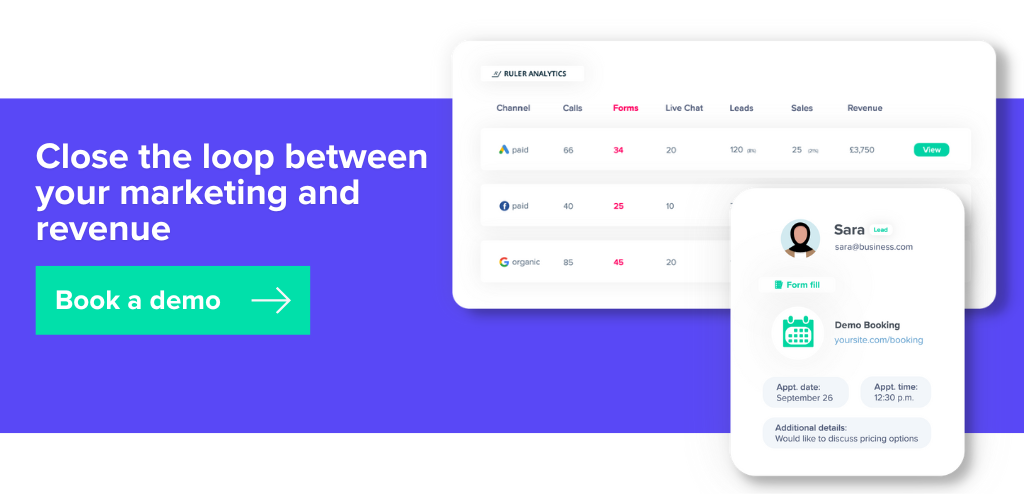Measure the impact of your marketing on sales and revenue with full-funnel attribution tracking.
Sales and marketing teams have more channels than ever to convert leads into revenue.
Studies have shown that customers use up to 10 digital channels throughout the buying process.
With the increase in marketing channels and higher demand for information, consumers are using considerably more touchpoints along their path to purchase.
As a result, understanding and tracking the customer journey from start to finish has become an increasingly complex issue for marketing and sales teams.
But there is a solution, and it simply comes down to full-funnel attribution.
For this article, we’ll discuss:
💡 Pro Tip
Apple’s iOS 14.5 update and Google’s third-party cookie phaseout has made traditional multi-touch attribution less effective. Here at Ruler, we’re on a journey to combine multi-touch attribution and marketing mix modeling (MMM) to create a more effective approach to marketing measurement.
Book a demo and find out more
The full-funnel attribution model considers every touchpoint in the customer journey. Whenever a lead converts into a won deal, the full-funnel attribution model will assign equal value to each touchpoint that played a significant role in the transaction.
It essentially allows marketers to take a holistic, high-level look at how well their marketing efforts are impacting the bottom stages of the funnel.
For example, you may consider the following stages as your most crucial touchpoints in the funnel.
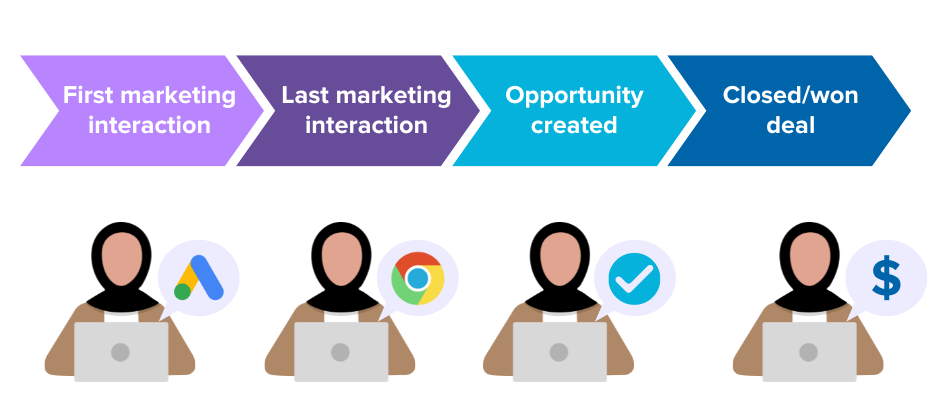
In this particular journey, you can see that Google Ads and search played a significant role in driving the lead to your website and converting it into an opportunity.
You could use this insight to allocate more budget to these channels to drive additional higher-converting customers for the sales team.
Sales and marketing misalignment is all too common.
For decades, businesses have treated sales and marketing as two separate departments.
When marketing makes a lead, they pass it to sales along with basic contact information such as name and email. Sales then take over to convince the lead to convert into a deal.
While this method sounds good in theory, in practice, it often fails to deliver and leads to financial consequences.
Studies have shown that when sales and marketing are misaligned, companies lose 10% of revenue or more each year.
Since marketing only has visibility into the early stages of the funnel, they lack insight into the quality and buying intent of leads that drop into the pipeline.
Related: How to track lead value
Sales, on the other hand, have no idea where conversions are coming from since the information is locked away in tools like Google Analytics.
The best sales can offer marketing is feedback on the quality of leads. But reporting back on whether leads are good or bad isn’t going to provide marketing with much detail on what is and isn’t working.
This is where full-funnel attribution comes in.
Full-funnel attribution unifies your sales and marketing teams.
It breaks down the data silos, allowing sales and marketing to share data and processes, plus gain a single source of truth on which marketing campaigns drive the highest converting leads.
At this point, you’re probably wondering why more marketers aren’t making use of full-funnel attribution.
A hyper-focus on data privacy has fueled the struggles around full-funnel attribution.
The death of third-party cookies and the launch of iOS 14.5 are mostly to blame.
Let’s take third-party cookies, for example.
Third-party cookies once played a significant role in digital attribution by allowing advertisers to track users across multiple websites and channels.
With third-party cookies, advertisers could attribute conversions to specific campaigns or touchpoints and measure the effectiveness of their digital campaigns.
But, third-party cookies have become increasingly restricted in recent years due to privacy concerns.
Safari and Mozilla Firefox have taken steps to phase out third-party tracking. And Google has said it’ll block third-party cookies by 2024.
The death of third-party cookies means that advertisers now have limited visibility into user interactions across different websites and devices. And are finding it increasingly difficult to attribute conversions and revenue back to the touchpoints that matter most.
Pro Tip
As third-party data becomes obsolete, many marketers are focusing on building up their first-party data. With first-party data, marketers can continue to track user interactions and attribute conversions across various marketing touchpoints.
All you need to know about third-party and first-party cookies
Data silo is another challenge holding back the potential of full-funnel attribution.
Often data is stored separately by different departments and teams within the same organisation.
For example, marketing will use analytics to measure traffic and conversions from specific channels. And sales will rely on data in the CRM to keep track of leads, opportunities and deals.
Data silos cause marketers a ton of grief.
When data is scattered across multiple systems, it stops marketers from seeing the customer’s buying cycle.
And this can lead to inconsistencies in data and inaccurate attribution of conversions and sales.
How can you optimise for maximum results if you don’t have visibility over your most influential marketing touchpoints?
The bottom line is you can’t.
Full-funnel attribution is typically used to track digital touchpoints such as online ads, social media, and email marketing.
It relies on cookies and pixels. These are placed on a user’s device, which allows you to track their online behaviour and interactions with digital touchpoints.
Offline media such as television ads, print ads, and billboards do not offer the same level of tracking capabilities as digital channels.
You can’t place a tracking pixel or cookie on a TV ad or billboard, right?
To address this issue, marketers have turned to alternative methods of measurement, such as marketing mix modeling, to understand the impact of offline media on conversions and revenue.
We’ll discuss this in more detail shortly.
Now that we’ve covered the benefits and limitations of full-funnel attribution, let’s look at the steps and tools involved to get you going.
Full-funnel attribution can be achieved using the four steps below:
In order to set up full-funnel attribution, you first need to map your users with their specific marketing touchpoints across multiple channels.
The best way to achieve this is with visitor-level tracking found within specific marketing analytics tools.
visitor-level tracking lets you track specific website users and how they got there before converting into a lead or sale.
With visitor-level tracking, it’s easier to determine which marketing efforts and landing pages have the greatest impact on your funnel.
Ruler, for example, tracks each and every anonymous visitor to your website over multiple sessions, traffic sources, keywords and more.
When a visitor converts via form, call or live chat on your website, their data is captured.
Ruler then matches the lead with their marketing touchpoints to create a picture of their customer journey.
We have plenty more content on how Ruler tracks full customer journeys if you want to learn more.
You’ll need a place to store all the marketing source data you’ve captured on your leads.
The best (and most common) place to store your marketing and lead data is a CRM.
By storing your data in the CRM, you can ensure your teams have access to the same data to gain a full view of the funnel.
As leads move closer to the finish line, you’ll be able to determine the effectiveness of your campaigns at every stage of your sales pipeline.
Obviously, manually adding marketing sources and conversion data to your CRM isn’t recommended.
You leave yourself exposed to human error, plus it’s a very time-consuming process.
But, with tools like Ruler, the job couldn’t be easier.
Ruler integrates with almost any tool, allowing you to seamlessly pass marketing source and conversion data to your CRM without the legwork.
Take the example below.
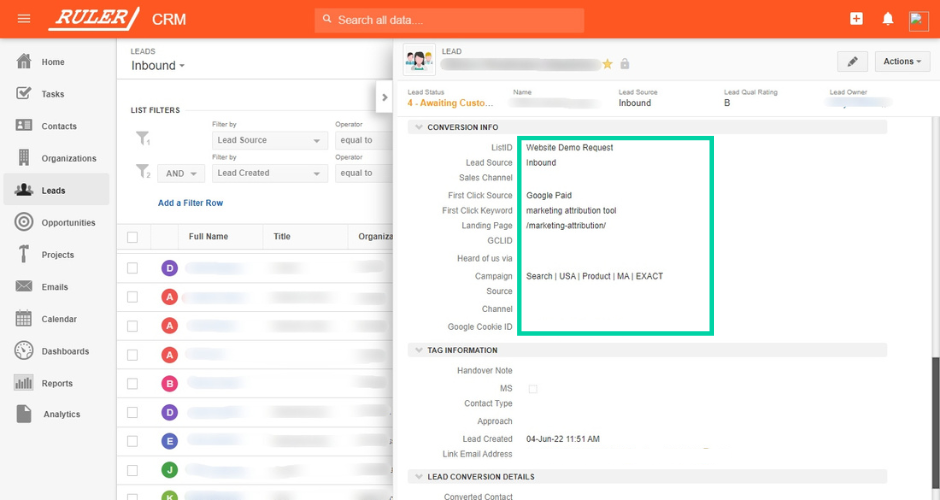
In this record, we can see that this lead converted after completing a PPC search and converted on our marketing attribution product page.
As our leads move closer to the finish line, we can use Ruler’s attribution data to determine the effectiveness of your campaigns at every stage of your sales pipeline.
Now for our favourite step.
Once a lead converts into a deal, it’s time to attribute it back to the original source.
Attributing revenue back to your marketing will forever change the way you optimise your campaigns.
Let’s use an example.
Below is impression, click and conversion data for three different Google Ads campaigns.
| Impressions | Clicks | Cost | |
| Ad Campaign 1 | 10,000 | 1,000 | £200 |
| Ad Campaign 2 | 5,000 | 100 | £200 |
| Ad Campaign 3 | 1,000 | 10 | £200 |
Without full-funnel tracking, you’d likely invest your money into campaign 1 as it’s the clear top performer. For the same cost, it drove 100 times more clicks than campaign 3.
Now, let’s apply revenue data from the CRM using full-funnel attribution.
By adding revenue data, we can now see that although ad campaign 1 drove the most traffic, ad campaign 3 generated the most revenue.
| | Impressions | Clicks | Cost | Revenue |
| Ad Campaign 1 | 10,000 | 1,000 | £200 | £400 |
| Ad Campaign 2 | 5,000 | 100 | £200 | £1000 |
| Ad Campaign 3 | 1,000 | 10 | £200 | £2000 |
Applying revenue data and attribution from the CRM has painted a completely different picture of the performance of these campaigns.
Any marketer in their right mind would now allocate their budget towards campaign 3.
If you were to use a tool like Ruler, you’d be able to automatically match revenue back to the marketing channel, campaign, keyword and more.
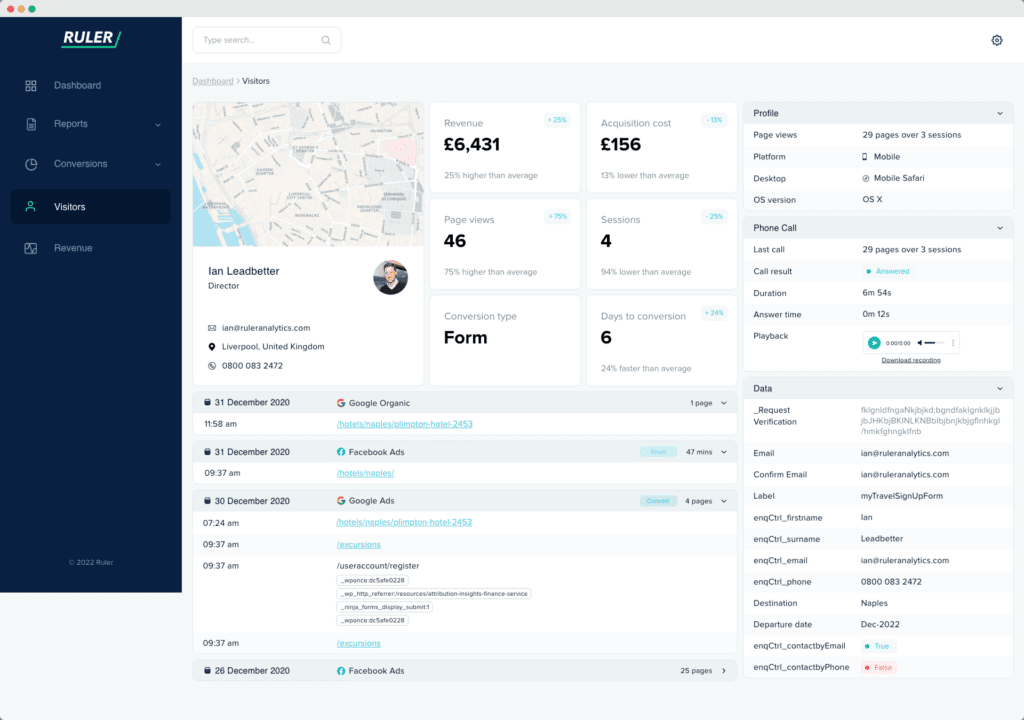
Here, marketing and sales teams can build reports showing exact values for marketing-generated revenue.
More importantly, sales and marketing teams can work together to build content and campaigns that drive higher converting leads and customers.
It’s a win-win for everyone involved.
If you work in SaaS or have clients on retainer, chances are you’re tracking monthly recurring revenue.
With that in mind, you’ll likely want to know how your marketing is impacting your business in the long run.
Ruler can help with that too.
Using our platform, we send our marketing source and revenue data to Chartmogul.
Related: How Ruler uses ChartMogul to close the loop between marketing and revenue
In Chartmogul, we’ve set up custom fields to capture key information about our marketing campaigns, allowing us to see which of our efforts have the greatest impact on our long-term growth.

We then use this insight to allocate budget and produce strategies around the marketing channels and topics that have proven to have the best lifetime value.
Full-funnel attribution has given us a more holistic understanding of the customer journey and allowed us to better allocate resources, optimise campaigns, and improve overall marketing effectiveness.
While attribution is a powerful tool, it comes with hurdles. We’ve already discussed the struggles around iOS 14.5 and the death of third-party cookies.
But there are a few other limitations you need to be aware of:
To overcome these challenges above and the cookie apocalypse, we’re using marketing mix modeling alongside our multi-touch attribution technology.
Related: What is marketing mix modeling and how does it work?
Unlike digital attribution, marketing mix modeling looks at the overall impact of a company’s marketing activities on business outcomes.
MMM takes a holistic approach to analysing marketing impact by looking at all of the different channels and tactics a company uses to promote its products or services and how they work together to drive sales or revenue.
This includes both online and offline channels, such as TV ads, social media, email campaigns, and in-store promotions.
Attribution still plays a key role in our marketing measurement. We use it to track our click path data and enrich our CRM with information about lead’s online activity.
But we use marketing mix marketing to collect aggregate, long-term data, to understand the impact of our invisible touchpoints (e.g. ad views, TV and radio).
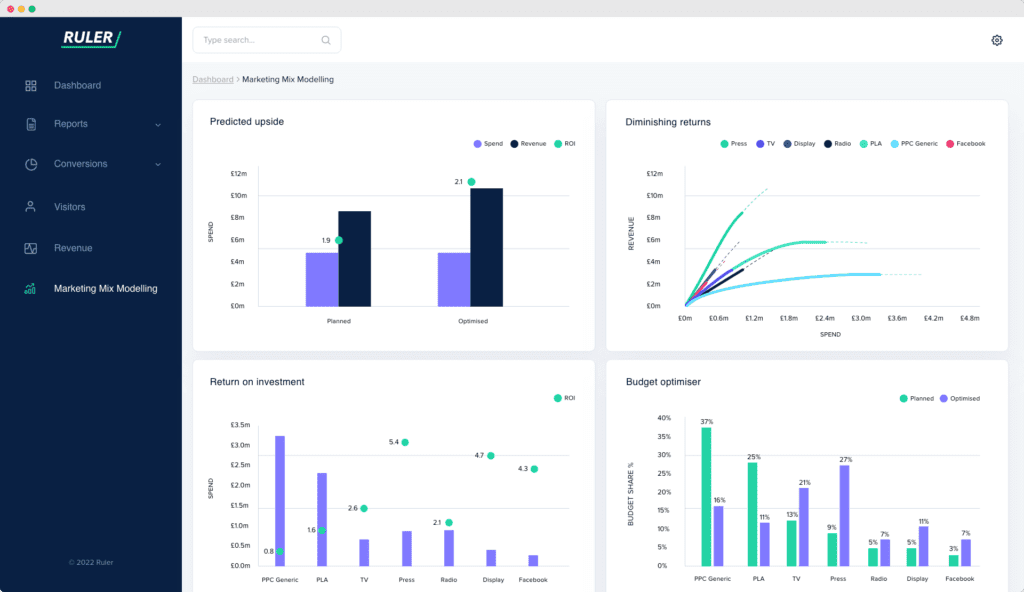
By combining digital attribution and MMM, we’re able to:
You can book a demo to hear more about the opportunities of marketing mix modeling here.
Once you start using your full-funnel attribution, you can expect to uncover insights that will directly impact your marketing operations, revenue, and growth.
That’s all anyone working in sales or marketing wants, right?
Remember, Ruler makes the process of full-funnel attribution a breeze.
It tracks your data on a visitor-level from awareness to conversion, allowing you to track which touchpoints have the greatest impact on your customer journey and revenue.
And, if that’s not enough, Ruler has MMM tracking so you can figure out the optimal media budget allocation between online and offline channels.
Want more information? Learn everything you can discover in Ruler or book a demo to see it in action for yourself.
